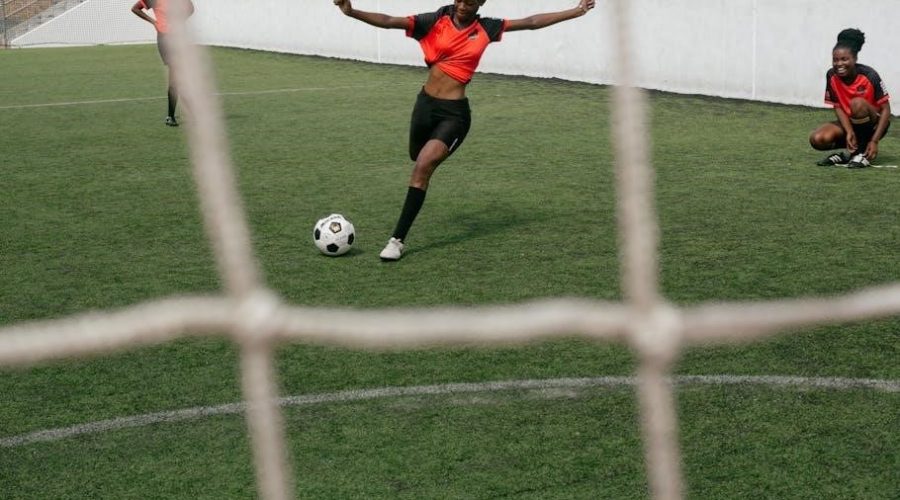Effective U10 soccer practice plans focus on skill development through structured, fun activities. These plans include drills, games, and exercises tailored to enhance dribbling, passing, and teamwork in young players.
Overview of U10 Soccer Development
U10 soccer development focuses on enhancing foundational skills like dribbling, passing, and ball control. Players at this age begin to understand game scenarios and teamwork. Structured practice plans introduce technical drills, small-sided games, and exercises to improve decision-making. The emphasis is on creating a positive learning environment where players can build confidence and master basic techniques. Coaches use age-specific strategies to ensure drills are engaging and challenging. This stage is critical for developing players’ ability to apply skills in game-like situations, laying the groundwork for future success in soccer.
Importance of Structured Practice Plans
Structured practice plans are essential for U10 soccer development, ensuring sessions are organized, efficient, and tailored to skill improvement. These plans help coaches deliver consistent training, focusing on key areas like dribbling, passing, and teamwork. By following a structured approach, players stay engaged and motivated, as activities are designed to be both challenging and fun. Structured plans also promote accountability, ensuring that each session builds on previous skills and prepares players for game situations. This methodical approach fosters a positive learning environment, allowing young athletes to develop technically and tactically while maintaining a love for the game. Consistency is key to their growth and success in soccer.
Key Characteristics of U10 Players
U10 players are typically between 8-10 years old, marking a developmental phase where they begin to show improved coordination, balance, and spatial awareness. At this age, their attention span increases, allowing for more complex instructions and drills; They are energetic, curious, and eager to learn new skills, making structured practice plans highly effective. U10 players also start to demonstrate better teamwork and communication skills, though they may still focus primarily on individual play. Their growing confidence on the field encourages creativity and experimentation with the ball. Coaches should leverage their natural enthusiasm by incorporating fun, challenging, and age-appropriate activities to foster technical and tactical growth.
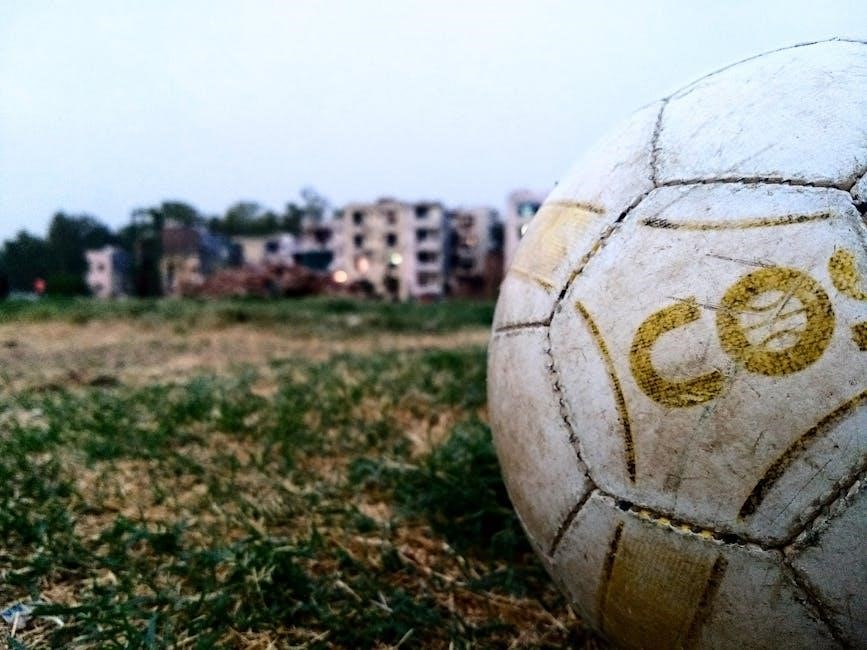
Warm-Up Routines for U10 Players
Effective warm-ups for U10 players should include dynamic stretching, ball familiarization, and agility exercises to prepare them physically and mentally for practice while keeping it engaging and fun.
Dynamic Stretching Exercises
Dynamic stretching is a crucial part of U10 soccer warm-ups, designed to prepare young players for physical activity by improving flexibility and range of motion. Exercises like high knees, leg swings, and arm circles are effective. Players should move through these stretches actively, mimicking soccer movements. For example, carioca drills (side-to-side shuffling) and lunges with twists engage multiple muscle groups. These exercises help increase blood flow and reduce injury risk. Coaches should ensure stretches are performed at a moderate pace, lasting about 8-10 minutes. Incorporating dynamic stretches keeps the session engaging while preparing players for the upcoming drills and games.
Ball Familiarization Drills
Ball familiarization drills are essential for U10 players to build confidence and control with the ball. These exercises focus on basic techniques like dribbling, rolling, and pushing the ball. Activities such as “Dribble Through Cones” or “Ball Tag” encourage players to keep the ball close while navigating obstacles. Coaches can incorporate games where players perform moves like step-overs or inside cuts, fostering creativity. These drills also help develop foot-eye coordination and balance. By keeping the sessions fun and engaging, young players can master fundamental skills, laying a strong foundation for more complex techniques later on. Regular practice ensures they become comfortable and confident with the ball at their feet.
Agility and Movement Exercises
Agility and movement exercises are crucial for U10 players to enhance speed, coordination, and overall physical fitness. Drills like ladder runs, cone zig-zags, and shuttle sprints improve quick footwork and acceleration. Players can navigate cone mazes or participate in relay races to boost their agility; Incorporating games like “Red Light, Green Light” with soccer-specific movements adds fun while developing reaction time and balance. These exercises prepare young athletes for the dynamic demands of soccer, helping them change direction swiftly and maintain control during matches. By focusing on these skills, players build the foundation needed for advanced techniques and game situations. Regular practice ensures they stay agile and responsive on the field.
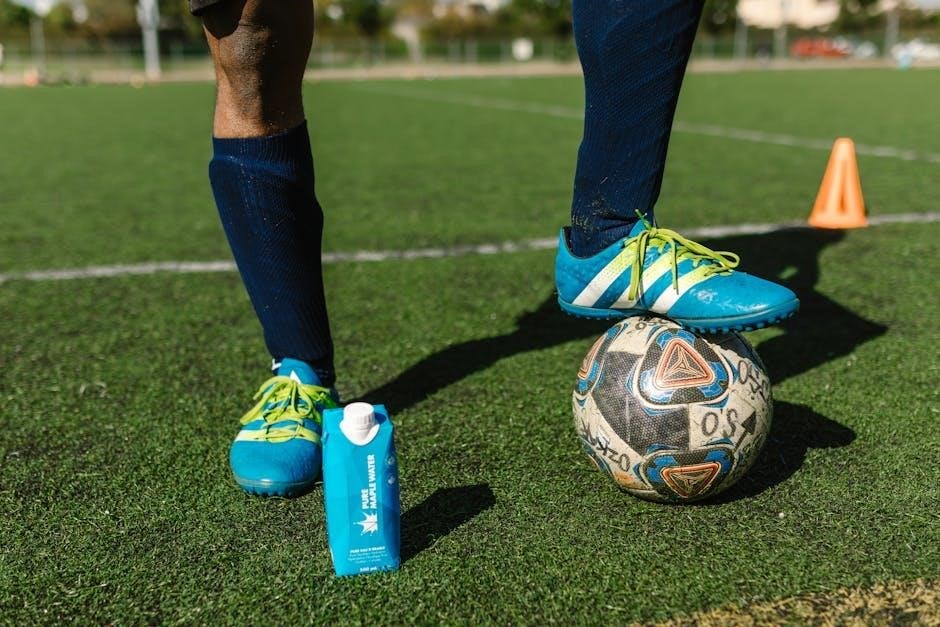
Technical Drills for Dribbling
Dribbling drills for U10 players focus on ball control and confidence. Ladder drills improve footwork, while 1v1 challenges simulate game scenarios, teaching players to protect the ball.
Dribbling Through Cones
Dribbling through cones is a fundamental drill to improve ball control and agility. Set up cones in a zigzag or straight line pattern, with varying distances apart. Players weave through the cones using different parts of their foot, focusing on precision and speed. This drill enhances coordination and confidence, preparing players for game situations. Progress by adding gates or small targets to dribble through, encouraging accuracy. Time challenges can also be incorporated to motivate players to complete the course faster while maintaining control. This exercise is essential for developing the technical skills needed for effective dribbling in matches.
1v1 Dribbling Challenges
1v1 dribbling challenges are dynamic drills designed to enhance a player’s ability to maintain possession and outmaneuver opponents. Set up a small field or grid, dividing players into pairs. One player starts with the ball, attempting to dribble past their defender into a designated scoring zone. The defender aims to win the ball or block the attacker. Rotate roles after each attempt to ensure all players participate. This exercise improves decision-making, balance, and the use of moves like step-overs or feints. Encourage players to stay low, use different parts of their foot, and keep the ball close; Add variations, such as time limits or multiple attackers, to increase complexity and simulate game scenarios.
Protecting the Ball in Tight Spaces
Protecting the ball in tight spaces is a crucial skill for U10 players, enhancing their ability to maintain possession under pressure. Set up a confined area (e.g., 5×5 grid) and divide players into pairs. One player starts with the ball, while the other applies gentle defensive pressure. The attacker must use their body to shield the ball and navigate the space without losing possession. Incorporate time limits or add a second defender to increase difficulty. Coach players to stay low, use their arms to protect the ball, and keep it close to their feet. This drill builds confidence, balance, and spatial awareness, simulating game-like scenarios where players must retain the ball in crowded areas.
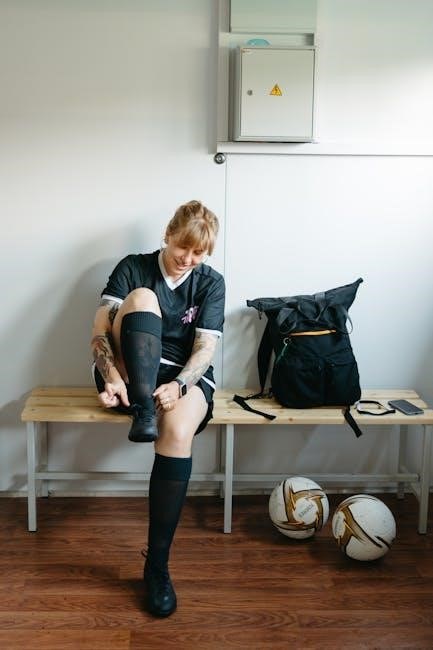
Passing and Receiving Skills
Passing and receiving are fundamental skills for U10 soccer players. Drills focus on short passing accuracy, first touch control, and movement to create scoring opportunities. Structured practices help players master these techniques through repetition and game-like scenarios, building confidence and teamwork on the field.
Short Passing Accuracy Drills
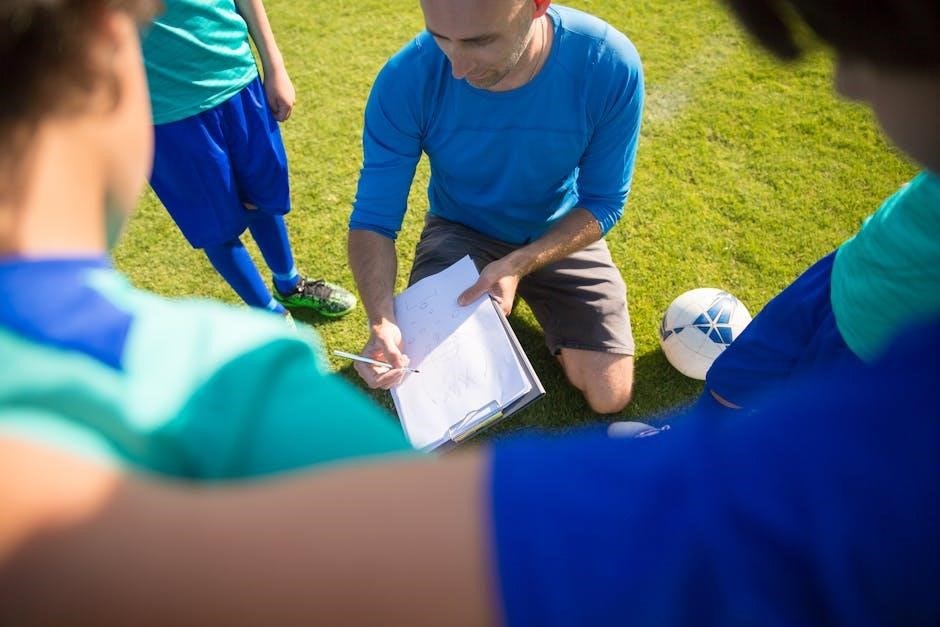
Short passing accuracy drills are essential for developing U10 players’ ability to control and distribute the ball effectively. These exercises typically involve pairs or small groups, focusing on precise, grounded passes over short distances. Players line up in pairs, with cones marking a 5-10 yard grid. They practice using the inside of their foot, emphasizing ankle lock and follow-through for accuracy. As players improve, the distance increases, and movement is incorporated to mimic game-like scenarios. Coaches encourage quick decision-making and stress the importance of weight and placement in passes. These drills build confidence and lay the foundation for more advanced passing techniques in future practices.
First Touch Exercises
First touch exercises are critical for U10 players to master ball control and decision-making. These drills focus on receiving passes accurately and comfortably using different parts of the foot. Players are paired or arranged in small groups, with one passing to another who must control the ball immediately. Coaches emphasize proper technique, such as cushioning the ball with the inside, outside, or sole of the foot. Drills progress to dynamic movements, where players receive passes while moving in various directions. This builds agility and the ability to control the ball in game-like scenarios. Effective first touch exercises enhance a player’s confidence and ability to maintain possession under pressure, making them a cornerstone of U10 soccer development.
Wall Pass and Move Drills
Wall pass and move drills are excellent for improving passing accuracy and spatial awareness. Players line up and take turns passing the ball against a wall or to a teammate, then move into open space. Coaches emphasize using the inside, outside, and sole of the foot for variety. The drills progress to dynamic movements, where players pass and immediately move to receive the ball in a new position. This enhances teamwork and decision-making. Wall pass drills are engaging and effective for developing U10 players’ ability to maintain possession and create scoring opportunities during games.
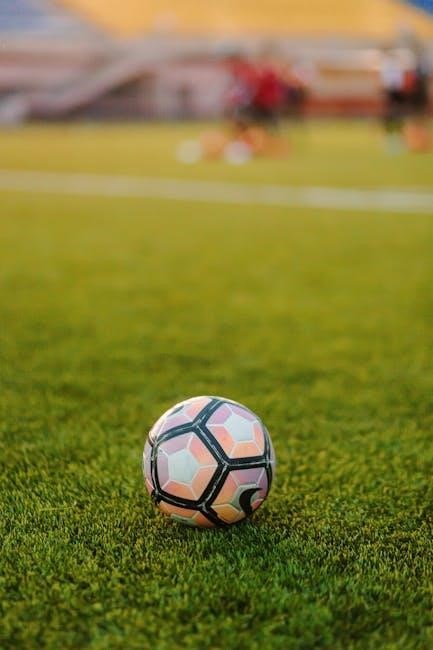
Shooting and Finishing Techniques
Shooting drills focus on proper ball striking and accuracy. Players practice shooting from various angles and distances, emphasizing follow-through and placement. These exercises build confidence and precision.
Basic Shooting Technique
Mastering the basic shooting technique is essential for young players. Start with proper stance, feet shoulder-width apart, and knees slightly bent. Players should strike the ball with the laces, ensuring a firm contact point. Emphasize follow-through, keeping the shooting foot extended and the ankle locked. Practice shooting from different distances, beginning with close-range shots to build accuracy. Gradually increase difficulty by moving farther from the goal. Incorporate drills where players shoot while moving and under light pressure to simulate game scenarios. Focus on balance and composure, encouraging players to keep their eyes on the ball throughout the strike.
Breakaway Shooting Drills
Breakaway shooting drills are designed to simulate game-like scenarios where players must quickly capitalize on scoring opportunities. Set up a cone path leading to the goal, with players starting 20 yards out. On the coach’s signal, players dribble through the cones and shoot on goal. Add a defender to increase pressure, requiring players to use moves to evade and maintain control. Incorporate variations, such as starting from different angles or adding a pass from a teammate. This drill improves decision-making, speed, and accuracy under pressure. Emphasize proper shooting technique and composure in one-on-one situations with the goalkeeper.
Shooting from Different Angles
Shooting from different angles is a vital skill for U10 players to master, as it expands their scoring opportunities during games. Set up stations at varying angles to the goal, such as 0°, 45°, and 90°, to simulate real-game scenarios. Players line up behind each station with a ball and take turns shooting. Incorporate a goalkeeper to add pressure and realism. Rotate players through each station to ensure they practice shots from the front, wings, and tight angles. Emphasize proper shooting technique, such as plant foot placement, striking with laces, and follow-through. Progress by adding movement before the shot, like a feint or step-over, to simulate game-like conditions. This drill improves accuracy, confidence, and versatility in front of the goal.
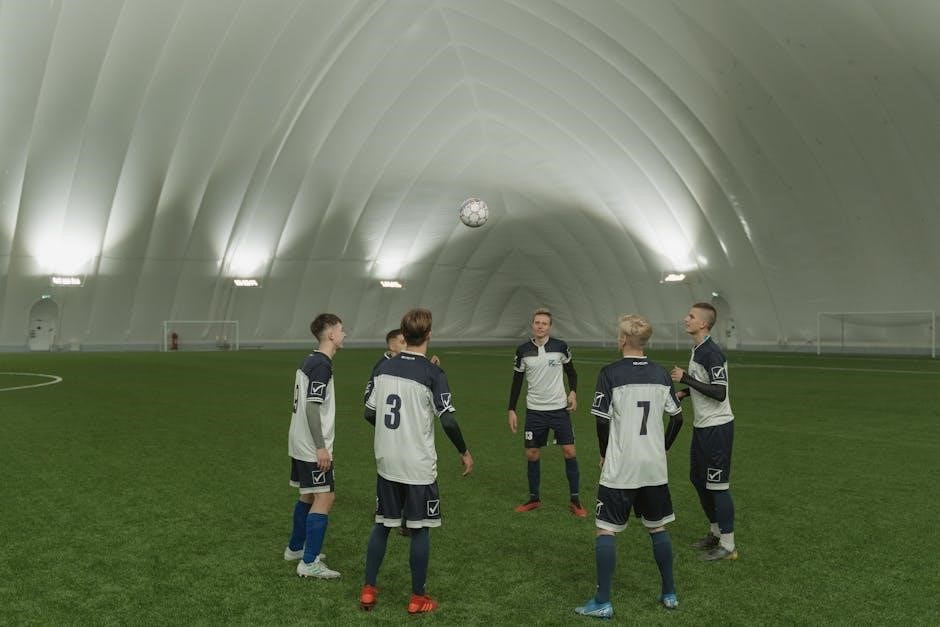
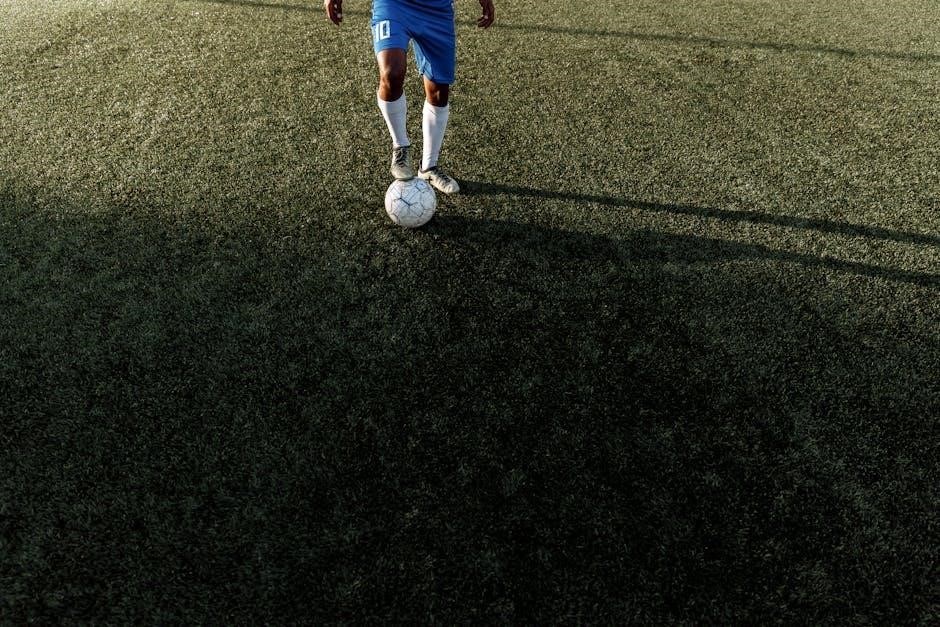
Small-Sided Games for Skill Development
Small-sided games, like 2v2 and 3v3, foster skill development in tight spaces. They improve decision-making, ball control, and teamwork, preparing players for competitive match scenarios effectively.
2v2 Endzone Games
Set up a 30×40-yard field with small endzones at each end. Divide players into teams of two, aiming to dribble the ball into the opponent’s endzone. Objective: Score by maintaining possession and navigating the ball into the designated zones. This game enhances ball control, spatial awareness, and teamwork. Coaching Points: Encourage players to use feints, quick decisions, and effective communication. Gradually introduce restrictions, such as limited touches, to challenge players. Rotate teams frequently to ensure equal participation. This engaging format promotes skill development while fostering a competitive yet fun environment, ideal for U10 players to refine their techniques in match-like scenarios.
3v3 Possession Games
Set up a 30×40-yard field, creating a small endzone at each end. Divide players into teams of three, with the objective of maintaining possession and scoring by dribbling the ball into the opponent’s endzone. Rules: Encourage ball control, quick decision-making, and teamwork. Introduce restrictions like “three-touch max” to challenge players. Rotate teams frequently to ensure equal playtime. Coaching Points: Focus on spatial awareness, effective communication, and using simple passes to retain possession. This game fosters tactical understanding, promotes physical activity, and enhances problem-solving skills in a dynamic, engaging environment tailored for U10 players to thrive.
4v4 Scrimmage with Restrictions
Organize a 4v4 scrimmage on a 30×40-yard field with small goals or endzones. Objective: Teams must maintain possession and score by dribbling into the opponent’s endzone. Introduce restrictions such as “two-touch passing only” or “no dribbling allowed” to emphasize teamwork and decision-making. Coaching Points: Encourage players to move without the ball, communicate effectively, and use simple, accurate passes. This format promotes possession-based play, improves spatial awareness, and challenges players to think critically under pressure. Rotate players frequently to ensure balanced participation and adapt rules to suit skill levels, keeping the game dynamic and engaging for U10 players.

Cool-Down and Flexibility Exercises
Conclude practice with static stretching, focusing on hamstrings, quads, and calves. Incorporate team bonding activities like partner stretches or group discussions to reflect on the session.
Static Stretching Routine
A proper cool-down involves static stretching to improve flexibility and reduce muscle soreness. Start with hamstring stretches by sitting on the ground with legs extended, reaching toward toes for 20-30 seconds. Next, stretch quadriceps by standing and grabbing one ankle, holding for 20-30 seconds per leg. Calf stretches can be done by leaning against a wall with one leg back, pressing the heel toward the ground. Incorporate hip flexor stretches by kneeling on one knee with the other foot forward, pushing hips forward gently. Finish with chest and shoulder stretches to enhance overall mobility. Ensure each stretch is held for 20-30 seconds and supervised for proper form.
Team Bonding Activities
Team bonding activities are essential for fostering camaraderie and trust among players. Incorporate fun exercises like group relays, where players work together to complete tasks. Scavenger hunts or problem-solving games encourage collaboration and communication. Small-sided games like 2v2 or 3v3 with unique rules, such as no dribbling, promote teamwork and creativity. Pair players for interviews to share fun facts, helping them get to know each other better. End practices with a team huddle to celebrate achievements and set goals for the next session. These activities create a positive environment and strengthen the team’s unity, making them more cohesive on and off the field.
Reviewing the Practice Session

Reviewing the practice session is crucial for reinforcing learning and improving future performances. Coaches should summarize key moments, highlighting successes and areas for improvement. Encourage players to reflect on their experiences, sharing what they enjoyed and what challenged them. Set clear, achievable goals for the next session, ensuring players feel motivated. Positive reinforcement and constructive feedback help build confidence and skill. End with a team discussion to align on priorities and celebrate progress. This structured review ensures players leave practice with a clear understanding of their growth and what to focus on next. It also fosters a culture of continuous improvement and teamwork.
Additional Resources and PDF Downloads
Download comprehensive U10 soccer practice plans in PDF format, featuring drills, exercises, and strategies to improve young players’ skills. Tailored for effective youth soccer development.
Downloadable U10 Practice Plan PDF
Enhance your coaching with downloadable U10 soccer practice plans in PDF format. These resources include detailed drills, exercises, and strategies tailored for young players. Each plan focuses on improving specific skills like dribbling, passing, and shooting, while promoting teamwork and sportsmanship. The PDFs are organized by session, offering a structured approach to skill development. They also feature coaching tips, ensuring effective implementation. Perfect for both experienced and new coaches, these plans help create engaging and productive training sessions. Download now and elevate your team’s performance with expertly designed exercises and activities.
Supplementary Drills for Advanced Players
For advanced U10 players, supplementary drills are designed to challenge their skills further. These include complex ball control exercises, advanced 1v1 moves, and high-intensity shooting drills. Players can engage in small-sided games with specific restrictions to enhance decision-making and creativity. Additionally, drills focusing on turning and shielding the ball in tight spaces are introduced to refine technical abilities. These exercises aim to prepare advanced players for more competitive gameplay while maintaining a fun and engaging training environment. Coaches can tailor these drills to meet the needs of their team, ensuring continuous growth and development in a structured format.
Coaching Tips for Effective Sessions
Coaching U10 soccer effectively requires a balance of structure, engagement, and positivity. Start with a clear practice plan, ensuring drills are age-appropriate and progressively challenging. Keep players focused by maintaining a high activity level and minimizing downtime. Use positive reinforcement to encourage effort and teamwork, fostering a growth mindset. Incorporate small-sided games to simulate real-game scenarios, promoting decision-making and problem-solving. Provide specific, constructive feedback to help players improve. Encourage creativity and allow players to try new skills in a supportive environment. End each session with a review of key takeaways and a preview of the next practice to maintain engagement and continuity.
